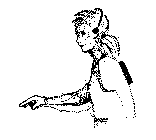Options and Futures
Sound Track
Sound Track

In common Virtual Reality systems, a drawn 3-D view of a model world is
changed in accordance with the movements of a human user in the
real world; if the user turns his or her head, the view shifts;
if the user moves a real hand, a drawing of a virtual hand moves
accordingly.
But how does a VR system know where its user's hand is?
There are many possible approaches to this; one that is frequently
employed in commercial system is the Polhemus.
A Polhemus tracker is a small cube - one or two inches in height - that
is connected
to a heavier ``base station'' with thin cables. The movements of the
cube in an electromagnetic field that the base station emits can be
sensed and transmitted to a computer in some way.
Once the position of the cube is known, it can be used to
control anything: commonly a position of a virtual
object or of the camera, but just as well the pitch of a sound,
or the hue of a color.
The system I have in mind consists of
one or two motion trackers (the lighter and less obtrusive, the better),
an audio output device, and
a game console with some exchangeable storage medium,
like those used for home videogames. In the
console is a small computer than can execute programs on
cartridges.
For this small, portable platform, different applications
can be bought:
- Musical instruments.
(Think Laurie Anderson rather than Nigel Kennedy.)
The user can ``pick up'' kinds of sounds by moving the trackers
in and out of a certain space; after that, pitch and amplitude
are modulated in the remainder of the space.
As a next step, the cartridge is replaced by a cable connecting
the system to a PC; the PC runs a development system on which
different ``instruments'' can be designed and programmed using a
visual programming language.
- A training system for Tai Chi, or at least a system that accompanies
these moves by appropriately soothing New Age music; or more
``aerobic'' systems where, for example, the speed of the music
adapts to the speed of the person exercising.
- A one-player motion puzzle.
The object of the game is to advance through a database of
sounds.
The player advances by making the ``right'' motions with the
tracker.
The game gives hints as to which motions it wants the player
to make by making certain sounds, or by modulating base sounds
in a certain way; and it gives feedback about the actual
motions made.
Credits
Kudos to the Very Nervous System and related work by David Rokeby for
teaching me that even inexperienced users can make interesting sounds.

